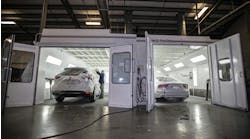The big automakers have been especially scorched by this escalating cost of key commodities coupled with a lack of consumer demand for the finished vehicles. The large scope and fixed costs of these overhead-heavy operations have made them visibly vulnerable to steel’s upswing as they, in turn, demand price reductions from their suppliers.
As aftermarket manufacturers also face rising commodity costs and diminishing profits, they too are forced to either eat that extra expense or pass it along to the end-user, which in this case, includes the aftermarket distribution chain.
Yet even while aftermarket manufacturers report considerable dismay over their surging material costs, others see advantages for the aftermarket compared to original equipment manufacturers, claiming that the aftermarket’s more-flexible supply chain is better able to absorb a few percentage points worth of price hikes.
“In the aftermarket, they’re more likely to get pricing passed through than they would for the OEMs,” according to Martin King, an analyst for Standard & Poors.
Lance Ealey, head of automotive research at The Freedonia Group, agrees. “The aftermarket does have a bit of a shield” based on its ability to make across-the-board price increases to a wide customer base, he says.
Because so many of the parts purchased through the aftermarket are necessary to keep a vehicle running, demand is likely to remain somewhat steady and competitive within the industry, providing there is uniformity with the pricing process.
“If you need a drum and rotor and it’s $50 instead of $40, it’s not going to stop you from getting it,” says Richard H. Morgan, president and CEO of the Aftermarket Auto Parts Alliance.
“The vendors’ price increases on raw materials have been tremendous, and I know they haven’t passed them all along yet,” Morgan reports.
“Vendors know that they have to stay competitive” with their pricing strategies, Morgan says. “All we do is take the price increases and pass them on” to the membership.
It is unlikely, according to Morgan, that these price boosts will prevent consumers or professionals from buying the parts necessary to keep a vehicle on the road.
Morgan expresses confidence that the higher costs will be evenly applied throughout the marketplace, thus lessening the blow in any one area.
“As long as everybody gets it and all the competitors are equally impacted, then it’s equitable,” observes Mike Lambert, president of the Parts Plus program group. “The only thing you can do is demand equity in the pricing.”
The prices paid by Parts Plus have already risen 3 percent to 5 percent, and Lambert expects an increased pace of pricing pressure going into 2005.
Of course, the cost of some product lines will rise higher based on raw material content, Lambert explains. “With a drum and rotor, you’ll have a greater price increase because it’s all metal,” he points out.
The AAPA has seen price increases stretching from 3 percent to a high of 12 percent thus far, and they too expect added across-the-board increases in the coming year.
“It’s free enterprise at work,” says Morgan. “We don’t like it and it hurts some people, but it’s supply and demand and that’s the way it works in the free enterprise system.”
“If our competitors are raising their prices as well, it shouldn’t impact us that much,” agrees Dan Freeman, president of the Automotive Parts Associates program group.
However, the Engine Pro/Engine Parts Group has considerable concerns. “Certainly we’re antsy because our primary products are metal products,” says President Greg Dunlap.
Engine Pro has purchasing agreements in place, but increases are being discussed as renewals become due. “We started to see supplier activity (toward price increases) about mid-year,” Dunlap recalls. “We’re just now starting to realize those changes.
“It’s been a great benefit to have pricing protections in place,” Dunlap says. “We’re not sure what the future holds for metals pricing. We think that they’re manageable today, but we don’t know if they’ll be manageable in six months; we’re watching it every day.”
Steel’s higher value makes scrap a more expensive commodity, and while Dunlap has yet to see a shortage of available engine blocks, other industry parts destined for rebuilding are being diverted for quick cash from scrap dealers. “Cores, in some respects, are drying up in that there’s increased value for the metal content.”
If the steel scenario forges any good news, it comes in the higher prices being paid for scrap — if you have rusting equipment in your shop or yard, now is the time to sell it.
In some instances, the prices paid for scrap metals of all types have been doubling and tripling. “China and India are gobbling up all the scrap they can,” says Lynn Hardin, national sales manager at Quality Steel Corp., which is active in the scrap marketplace.
Eroding margins
Industry manufacturers are seeing eroding margins amid ongoing struggles over obtaining the necessary raw materials. Some firms have a cushion of existing contracts with their steel suppliers at favorable terms. When the contracts do expire, though, new agreements have the steel producers dictating higher figures for what has become a precious commodity.
“The impact has been severe,” says Ana Lopes, director of government relations for MEMA, the Motor & Equipment Manufacturers Association. Raw material outlays are at a 20- to 30-year high, she says. Some companies have seen their costs escalate anywhere from 40 percent to 120 percent.
Operations are finding themselves in situations where it costs more to make a part than they can ever hope to sell it for. One manufacturer recently reported to MEMA that a part it has traditionally sold for a dollar now costs $1.10 to produce.
“How do you manufacture yourself around a 60 percent raw material cost increase?” Lopes ponders. “It has a very direct impact on the parts industry across the board — large and small companies.
“We’re not in a position to pass the costs forward to our customers given the competitive situation we’re in now,” Lopes continues, citing the rigors of a global marketplace coupled with the regulatory and wage burdens carried by U.S. companies.
“American parts manufacturers compete against parts manufacturers from all over the world,” she explains. Plus there are “the illegal trade practices” engaged in by other countries that place tight financial restrictions on the ability of U.S. firms to effectively compete.
MEMA pitched hard for an end to American steel tariffs, which ceased in late 2003, and efforts are going forward to seek other avenues of relief, Lopes says. “We don’t lobby on steel prices, but we are reaching out to Capitol Hill.”
The escalating worldwide demand for steel and its now-limited availability has rather quickly rendered the tariffs issue moot: in March of 2002, at the urging of domestic steel producers struggling to compete on price with cheaper overseas imports, the U.S. imposed a 30-percent fee on non-American made steel.
Within 15 months, the tariffs were rolled back as the World Trade Organization denounced the policy as a violation of international trade law. At the same time, American manufacturers — especially high-volume users in the automotive industry — that had relied on this cheaper imported steel were complaining that the tariffs were making a key commodity too expensive.
A continuing quandary
As higher material costs pummel profit margins, aftermarket suppliers are in a quandary over how to rectify the situation.
“Unfortunately, we’re living that nightmare,” says Michael Schwartz, chief business officer at Corsa Performance, based in Berea, Ohio.
“Ninety-five percent of our stuff is stainless steel,” he reports, referring to the company’s line of high-end exhaust systems that also contain titanium. “We certainly are nervous.”
Corsa’s material costs have increased some 25 percent since steel prices started rising. “We’re eating it and we’re passing it along,” says Schwartz, describing a 5 percent to 6 percent price increase they initiated in September.
The product line is sold to speed shop installers, car dealerships and via mail order; Schwartz says it remains unclear whether Corsa’s competitors are following suit with price increases of their own.
Less-expensive materials are not suitable substitutes because of the specialty nature of its performance line. “That’s not an option — we offer a lifetime warranty on our exhaust systems,” Schwartz explains, steeling a resolve to stick with stainless.
“It’s been ugly,” concurs Sandy Marchand, sales and marketing director for Valley Industries of Lodi, Calif. The company’s trailer-hitching equipment is all made of steel. “The market is very volatile, and we’re at the mercy of the steel mills at this point,” she says. “We’ve actually had four surcharges (imposed by steel suppliers) since March,” which amounts to an almost 25 percent rise in cost — with about 20 percent being shifted to the customer base. “It depends on the product line and the steel we’re using,” she reports.
“We’re passing our surcharges to the distributor and the distributor passes them on to the consumer,” Marchand says. “We do a pretty fair job of keeping up with our surcharges,” she adds, noting that Valley prefers to impose a steel surcharge rather than raise the actual price. “This way we have more flexibility.”
Flexibility is applied to the production process as well; the company has adjusted the size of steel sheets it purchases and reprogrammed its robotic equipment to make more efficient manufacturing maneuvers.
Marchand says that higher fuel prices are discouraging people from traveling too far from home — thus they’re not utilizing trailer hitches, and other hitch makers are seeing similar scenarios.
“Our competition is raising prices accordingly. We’re all in the same boat,” Marchand observes. She adds that they’ve been told to expect more surcharges as 2005 unfolds.
Feeling the heat
“It’s coming down the pike and there’s no way to stop it,” reports Jim Gillette, head of supplier analysis for CSM Worldwide.
For a new car rolling off the assembly line, the rise in steel prices adds some $300 to $600 to the cost of making that vehicle,
The metal now joins plastic as a key concern for those in the industry. Plastics pricing has been an issue since the late 1990s, based on the cost of oil and high U.S. demand for vinyl siding for homes. Even the biggest players in the parts industry are feeling furnace-like heat over the cost of both of these commodities.
“They’ve been struggling with commodity pricing for quite some time,” Gillette says. “The system is operating on razor-thin profit margins,” he points out. “It’s really grim right now because the price of steel is cutting into their margins.”
Transportation costs are higher as well, pushed by gushing oil prices plus a shortage of critical railcars needed to move material from mill to manufacturer. It is cheaper to move steel on a railcar, yet American steel users have been forced into buying shipments via truck, a problem exacerbated by tight domestic trucking availability.
American Axle & Manufacturing, Visteon, Tower Automotive, TRW, Lear, Federal-Mogul, Hayes Lemmerz, Dana and Delphi — the world’s largest auto parts supplier — are all noting difficulties attributed at least in part to steel’s climb. Operations such as Intermet and Citation have filed for bankruptcy, blaming soaring prices for scrap steel and other raw materials.
Delphi says it is embarking on a hiring freeze with plans to scale back its domestic workforce by 6,000 hourly employees by this month.
While being somewhat protected by existing contracts with its steel suppliers, “we’ve seen additional costs here with surcharges and the like,” explains Lindsey Williams, Delphi’s manager of corporate affairs. “We don’t break out the impact of steel on the aftermarket.” He declines to even speculate on what 2005 will bring to the aftermarket-pricing arena.
“We handle each case individually with our suppliers and customers.”
Sticker shock
Steel surcharges had a significant third quarter impact on Dana’s aftermarket division and its lines of brake, filter, steering and suspension products.
“It hurt their operation by $6 million for the quarter,” says Michelle Hards, Dana’s director of investor relations.
“We’re working with our customers to see what we can recover,” Hards explains, adding that pricing issues would now be in the hands of the division’s new owner, The Cypress Group.
In early November, Cypress and Dana agreed to a contract revision that lowered the price to $1 billion — some $100 million less than the original agreement reached in July. The sale was to close by the end of November. (At press time, Cypress’ pending $1.2 billion purchase of Cooper-Standard Automotive was tied up in federal court over an injunction against the deal granted to the United Steel Workers of America.)
A number of factors led to the reduction of the aftermarket division’s sale price, according to Hards. “I don’t know if it was the price of steel,” she reports. “Their overall performance is generally not what was expected in the third quarter.”
Cypress declines to comment since at press time they are still in the process of purchasing the division from Dana — but the steel issue does continue to be a concern for other large industry suppliers.
“As we expected, this was a challenging quarter for the automotive industry with elevated steel pricing and softening North American production volumes,” reports Larry Denton, president and CEO of Dura Automotive. “We identified these issues early on and managed our business aggressively to reduce the impact on our margins. While material pricing continues to be a challenge in the short-term, our organic growth remains on track,” Denton says.
Raw-material costs and price reductions from automakers has led to a larger third-quarter loss for Federal-Mogul despite increased revenues.
“New business and increased sales volumes highlighted our financial results during the third quarter,” says Steve Miller, the company’s chairman and interim CEO. “However, difficult market conditions including (the) increased cost of steel and other commodities and ongoing customer pricing challenges continue to pressure our financial results.”
Visteon’s fixed costs have the company in a real fix as it struggles to remain a potent presence while also trying to cope with ongoing raw materials increases.
Visteon executives are in intensive negotiations with Ford, its former parent and top customer, about selling or closing several unprofitable factories, cutting a portion of its 8,500 U.S. salaried employees and accelerating the transfer of factory workers back to Ford, according to sources from both companies interviewed by Eric Mayne of The Detroit News.
According to Mayne, who prepared an in-depth profile of the company, Visteon has been hit by several factors, including rising steel prices, over-optimistic projections and significant production cuts by Ford.
“Close observers believe the seeds for Visteon’s current problems were sown in 2000 when Ford hastily spun off its long-time parts division. Visteon hourly workers were guaranteed top-tier UAW wages and benefits that cost the company about $50 an hour — nearly twice what some competing suppliers pay,” Mayne reports. “The labor costs and Visteon’s broad array of products have made it difficult for them to offer world-class quality and cost in any area.
“At the same time,” Mayne continues, “Ford went into the tank shortly after the spinoff, losing billions of dollars and large chunks of market share. Since Visteon supplies roughly $3,000 in content per Ford vehicle, the automaker’s sales performance has an acute impact on its largest supplier.”
Mayne goes on to note, “Visteon still has 18,000 Ford employees making an average wage of $25 an hour in its factories, a vestige of the 2000 spinoff. Both companies say they want to accelerate the transfer of those workers back to Ford, which then allows Visteon to hire new workers at about $14 an hour.”
Irons in the fire
Steel industry executives recall a not-too-distant past when steel was literally cheaper than dirt — with a ton of topsoil selling for more than a ton of steel.
For years, large-volume steel consumers — such as original equipment manufacturers and others in the automotive realm — enjoyed enough clout to dictate a low pricing schedule to their steel suppliers. No more. What had long been a buyer’s market for steel has quite suddenly shifted into a seller’s market.
“It’s a classic supply and demand situation,” says Ealey, the Freedonia analyst. “It’s not just the United States,” he says. “This phenomenon is taking place across the globe.”
In 1999, hot-rolled steel sheet was selling for $290 per ton. Recently it was up to $714 a ton, according to the American Iron and Steel Institute. During 2004 alone, the price for hot-rolled rose 120 percent while cold-rolled went up 75 percent.
“Turn on the 6 o’clock news and you can see what we’re talking about,” says Parts Plus’ Lambert.
Steel’s upward flow is unlikely to abate for at least 18 months to two years, according to Gillette at CSM, who cautions that he is not an expert on steel pricing.
Mike Petro, category manager for metals at Ariba, says steel prices are expected to remain relatively flat for the first half of 2005.
Automotive suppliers are seeking shorter, more flexible contracts that allow leeway on steel pricing. Steel suppliers want longer-term deals, Petro points out.
“Prices may have peaked (and) they don’t want to get burned,” he says. For those in the automotive industry, “if the price goes down, they want to be sure they can take advantage of it.”
“The view is that prices will be flat to slightly down,” says King at Standard & Poors. Stressing that steel prices are extremely hard to predict, he notes that the hot Asian market could see considerable cooling — which would bring relief to American steel users.
“China is initiating some economic policies that will slow that growth down to a more manageable pace so the economy doesn’t overheat,” King reports.
“It is a commodity and prices are volatile,” says King. “Obviously it impacts the automotive market,” he continues, referring to questions of cost — or even sheer availability — that may have a greater impact on lower-volume steel customers.
“They’re more exposed to the recent run-up in prices,” King says. “If you’re smaller, you don’t have the clout to get the best prices. If there are shortages, they’re near the bottom of the list to get the steel they need.”
As for the steel industry, “some of these guys are (finally) starting to make money” after years of low prices, losses and employee cutbacks, according to Ealey. “The marginal players have gone bust. Some of the better players will expand capacity,” he forecasts.
The huge merger that recently combined three U.S. steel companies into a firm called Mattal is just that — a merger that emphasizes consolidation, efficiencies and profits more than expansion and job growth.
It remains unclear and doubtful that steel’s good fortune will lead to a revitalization of the many now-cold mills (and the video showing idled steel workers heading back to work at high-wage jobs) that tower over the American Rust Belt.
Supply and demand issues aside, some of these facilities are just too old and outmoded to ever be fired up again. “There’s been so many innovations and technological advances made in the past 10 years or so,” according to Gillette.
“It’s always difficult to restart a mothballed plant,” says Ealey. “It’s another cost that must be dealt with.”
As it stands now, steel’s future pricing remains an unknown factor facing the aftermarket.
“Ultimately we expect this to ease up,” says Ealey, “but at this point, my crystal ball goes opaque.”




